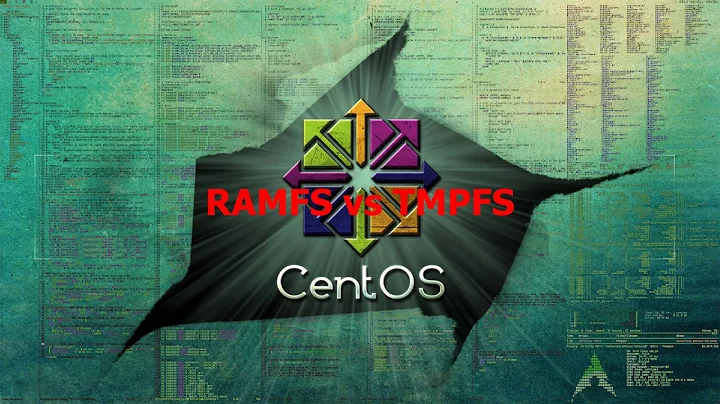Do tmpfs and devtmpfs share the same memory region?
Solution 1
For all the tmpfs mounts, "Avail" is an artificial limit. The default size for tmpfs mounts is half your RAM. It can be adjusted at mount time. (man mount, scroll to tmpfs).
The mounts don't share the same space, in that if you filled the /dev/shm mount, /dev would not show any more "Used", and it would not necessarily stop you from writing data to /dev
(Someone could contrive tmpfs mounts that share space by bind-mounting from a single tmpfs. But that's not how any of these mounts are set up by default).
They do share the same space, in that they're both backed by the system memory. If you tried to fill both /dev/shm and /dev, you would be allocating space equal to your physical RAM. Assuming you have swap space, this is entirely possible. However it's generally not a good idea and would end poorly.
This doesn't fit well with the idea of having multiple user-accessible tmpfs mounts. I.e. /dev/shm + /tmp on many systems. It arguably would be better if the two large mounts shared the same space. (Posix SHM is literally an interface to open files on a user-accessible tmpfs).
/dev/, /run, /sys/fs/cgroups are system directories. They should be tiny, not used for sizeable data and so not cause a problem. Debian (8) seems to be a bit better at setting limits for them; on a 500MB system I see them limited to 10, 100, 250 MB, and another 5 for /run/lock respectively.
/run has about 2MB used on my systems. systemd-journal is a substantial part of it, and by default may grow to 10% of "Avail". (RuntimeMaxUse option), which doesn't fit my model.
I would bet that's why you've got 50MB there. Allowing the equivalent of 5% of physical RAM for log files... personally it's not a big problem in itself, but it's not pretty and I'd call it a mistake / oversight. It would be better if a cap was set on the same order as that 2MB mark.
At the moment it suggests the size for /run should be manually set for every system, if you want to prevent death by a thousand bloats. Even 2% (from my Debian example) seems presumptuous.
Solution 2
Each tmpfs instance is independent so it's possible to overallocate memory, and if you fill up the entire memory with large files on tmpfs, the system will eventually halt due to no more memory available and not possible to free any (without deleting tmpfs files or umounting it).
tmpfs can use swap partitions to swap out data, but even that does not help if you're reading/writing those files actively at which point it has to be swapped back in.
Basically systems that have lots of instances of tmpfs mounted, usually operate under the assumption that although tmpfs is there, it won't actually be filled to the limit.
If you want to try this - preferably on a Live CD with nothing mounted - then it works like this:
mkdir a b c
mount -t tmpfs tmpfs a
mount -t tmpfs tmpfs b
mount -t tmpfs tmpfs c
truncate -s 1T a/a b/b c/c
shred -v -n 1 a/a b/b c/c
That creates three instances of tmpfs, by default each has a 50% memory limit so it's 150% in total (not counting swap, if you do have swap feel free to add d e f ...).
Output of shred will look something like this:
shred: a/a: pass 1/1 (random)...
shred: a/a: error writing at offset 1049104384: No space left on device
shred: b/b: pass 1/1 (random)...
# system hangs indefinitely at this point, without swap it never reaches c/c #
Solution 3
(1) All file systems based on tmpfs are sharing the OS available virtual memory as back-end. devtmpfs happens to use the same space but unlike the former, doesn't contain data so shouldn't grow.
(2) /run/users subdirectories are created by systemd as personal, transcient /tmp directories. They also share the same virtual memory space with all other tmpfs based file systems. The fact they appear smaller is due to a capping put in place to prevent a single user to affect all other users by filling this directory.
Related videos on Youtube
Nan Xiao
Updated on September 18, 2022Comments
-
Nan Xiao over 1 year
My system disk usage is like this:
# df -h Filesystem Size Used Avail Use% Mounted on /dev/mapper/rhel-root 50G 39G 12G 77% / devtmpfs 5.8G 0 5.8G 0% /dev tmpfs 5.8G 240K 5.8G 1% /dev/shm tmpfs 5.8G 50M 5.8G 1% /run tmpfs 5.8G 0 5.8G 0% /sys/fs/cgroup /dev/mapper/rhel-home 1.3T 5.4G 1.3T 1% /home /dev/sda2 497M 212M 285M 43% /boot /dev/sda1 200M 9.5M 191M 5% /boot/efi tmpfs 1.2G 16K 1.2G 1% /run/user/1200 tmpfs 1.2G 16K 1.2G 1% /run/user/1000 tmpfs 1.2G 0 1.2G 0% /run/user/0I have
2questions aboutdevtmpfsandtmpfs:
(1)devtmpfs 5.8G 0 5.8G 0% /dev tmpfs 5.8G 240K 5.8G 1% /dev/shm tmpfs 5.8G 50M 5.8G 1% /run tmpfs 5.8G 0 5.8G 0% /sys/fs/cgroupAll the above spaces are
5.8G, do they share the same memory space?(2)
tmpfs 1.2G 16K 1.2G 1% /run/user/1200 tmpfs 1.2G 16K 1.2G 1% /run/user/1000 tmpfs 1.2G 0 1.2G 0% /run/user/0Does each user has his dedicated memory space, not shared space in
/run/userpartition? -
user2948306 about 8 yearsYes, sorry! If you think the edit i better removed, please do.
-
CMCDragonkai over 4 yearsIs there a way to recover from the deadlock without restarting the computer?
![[DevOps Full Course from Beginner ] || 6 - Bash Scripting for DevOps](https://i.ytimg.com/vi/jWM9PW9ikvw/hqdefault.jpg?sqp=-oaymwEcCOADEI4CSFXyq4qpAw4IARUAAIhCGAFwAcABBg==&rs=AOn4CLABYOQzeEYOVjyvBJhtB1qLdylzWw)






